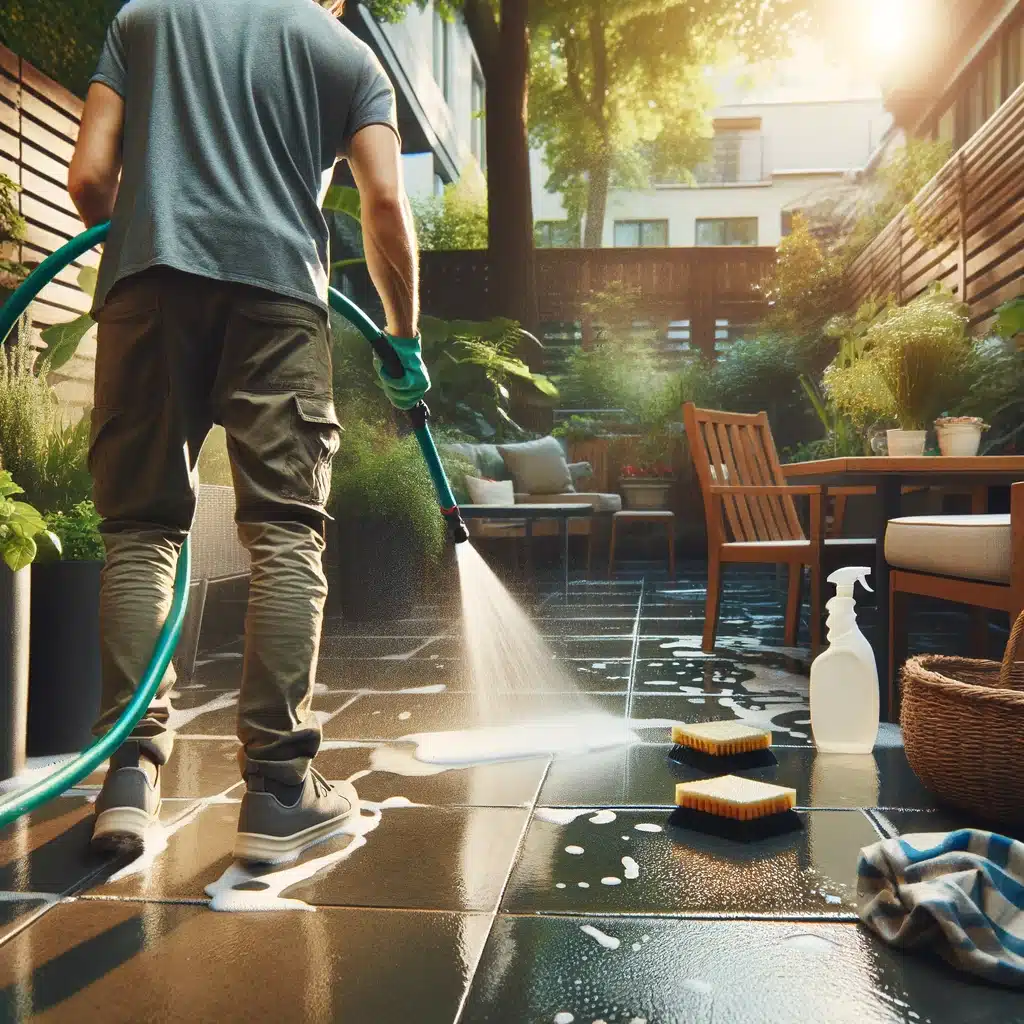5 Steps to Effective Patio Cleaning with Hose
Cleaning with Hose your patio clean is essential for creating an inviting outdoor space, especially during the warm months when you want to enjoy your backyard to the fullest. One of the simplest and most effective ways to maintain your patio is by cleaning with a hose. Here’s a step-by-step guide to make your patio sparkle: 1. Clear the Patio To kick off your patio cleaning session, it’s essential to start with a clear space. Begin by removing all furniture and accessories. This includes chairs, tables, potted plants, and any decorative items that might be adorning your patio. Clearing the area not only gives you full access to every nook and cranny of your patio but also prevents any accidental damage to your belongings while cleaning with a hose. By taking a few extra minutes to move everything out of the way, you set the stage for a thorough and efficient cleaning process. Once your patio is cleared, the next step is to address the loose debris. Grab a broom and start sweeping away any leaves, dirt, or small branches that have accumulated. This step is crucial because it removes the bulk of the dry debris that could otherwise turn into a muddy mess when water is introduced. A clean sweep ensures that when you start cleaning with a hose, the water can work directly on the surface dirt and grime without being hindered by loose particles. It might seem like a simple step, but thorough sweeping makes a significant difference in the overall cleanliness of your patio. Cleaning with a hose becomes much more effective once the patio is free from loose debris. Without small twigs and leaves getting in the way, the water can flow smoothly across the surface, targeting stubborn dirt and stains more directly. This preparatory step not only makes the hosing down process more efficient but also reduces the amount of time and effort required for scrubbing later on. So, taking a few minutes to clear and sweep your patio sets a strong foundation for a successful and satisfying cleaning session. 2. Pre-Treat Stains Before diving into the main cleaning with a hose, it’s essential to identify and pre-treat any stubborn stains on your patio. These stains might come from various sources such as spilled drinks, food, or natural elements like moss and algae that have taken hold over time. Thoroughly inspecting your patio and pinpointing these problem areas is the first step. Once identified, use a suitable cleaning solution to tackle these stains. A popular and effective choice is a mixture of baking soda and water, which is both gentle on surfaces and tough on stains. Apply this solution generously to the stained areas and allow it to sit for about 10-15 minutes to break down the grime. After giving the cleaning solution enough time to penetrate and loosen the stains, it’s time to roll up your sleeves and scrub. Use a scrub brush with stiff bristles to gently work on the stained areas. The key here is to scrub gently but thoroughly, ensuring you do not damage the surface of your patio while effectively lifting the stains. This preparatory scrubbing is crucial because it helps to break down the most stubborn spots, making them much easier to rinse away later when you start cleaning with a hose. The effort you put into pre-treating and scrubbing the stains will significantly enhance the overall cleanliness of your patio. Cleaning with a hose after pre-treating stains is much more effective. The combination of a high-pressure water stream and the pre-treated areas ensures that even the toughest grime and stains are washed away. By addressing stains beforehand, you ensure that your patio will look uniformly clean and refreshed once the entire cleaning process is complete. This method not only saves you time in the long run but also guarantees a more polished and professional finish, making your patio a pleasant and welcoming outdoor space. 3. Start Hosing Down Now that your patio is prepped and ready, it’s time to begin the main cleaning process. Start by attaching a nozzle to your hose. This small but crucial step allows you to control the water pressure, making your cleaning with a hose more efficient and effective. High-pressure settings are excellent for dislodging embedded dirt and grime, which can accumulate over time and become quite stubborn. Conversely, a gentle setting is ideal for rinsing away loose debris and ensuring that the surface remains intact without causing any damage. With the nozzle attached and adjusted to the appropriate setting, begin spraying the entire patio. This initial rinse helps to loosen any remaining dirt and debris, making it easier to clean the surface thoroughly. Start from one end of the patio and work your way systematically to the other, ensuring that every inch is covered. This methodical approach ensures that no area is missed and that the water pressure can effectively reach all the dirty spots. For areas that are particularly dirty or have more stubborn stains, you may need to go over them a few times. This repetition helps to ensure that all the grime is adequately loosened and ready to be washed away. Cleaning with a hose can be quite satisfying as you see the immediate impact of your efforts. As you spray, watch for areas where the dirt is particularly stubborn and adjust your water pressure accordingly. A high-pressure blast can break up tough dirt, while a gentle spray can be used to rinse off the loosened debris. This combination of techniques ensures a thorough cleaning. As you continue to work your way across the patio, the transformation will become evident, leaving you with a cleaner and more inviting outdoor space. 4. Apply a Cleaning Solution With the initial hosing down complete, it’s time to apply a cleaning solution tailored to your patio’s material. The choice of cleaning solution is crucial for achieving the best results without damaging your patio. For concrete and stone surfaces, a





